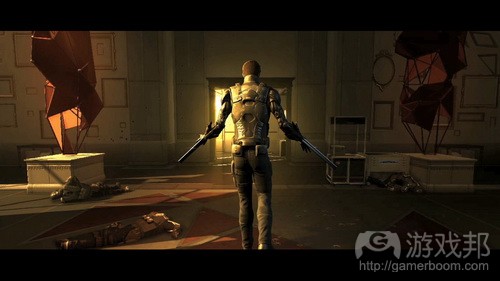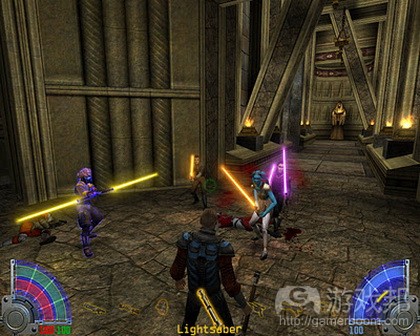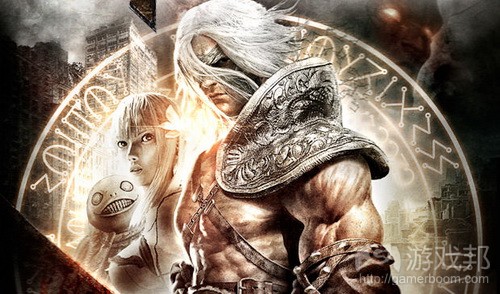论述游戏设计挑战性&复杂性的平衡关系
作者:Josh Bycer
一些老玩家在谈到他们以前所玩过的游戏时总是会强调难度这一元素。也就是说他们之前玩过的游戏比我们现在的难多了,所以也比较有趣。在我在之前关于设计难度的书中也说到了让经典游戏更具有挑战性这点非常重要。而如果一款游戏是因为糟糕设计或让人困惑的UI而颇具难度,那这便不算真正有趣的挑战。
近来有关《暗黑破坏神3》以及《黑暗之魂》(游戏邦注:《恶魔之魂》的续集)的难度谈论,老练游戏玩家开始做出反驳,他们认为具有难度的游戏非常有趣,问题出在玩家能力不足。但是我们需要明确的是制作一款复杂的游戏并非易事。一名优秀设计师真正需要注意的便是有效区分难度与挑战。
如果玩家认为自己在一款游戏中没有继续下去的理由或者因游戏而感到困惑,他们便不会继续玩这款游戏。合理的难度设置并不是指将玩家猛烈击倒在地,而是应该呈现出一些让玩家能够通过技能或角色发展而取胜的元素。为了区分这两个原理,我找到了一些能够有效平衡游戏难度的要点:
1.移除选择:
创造出优秀游戏设计的一大方法便是给予玩家各种选择。包括各种咒语、武器、操作和装备等。但是为了提高游戏难度,设计师会创造出一些特别情境,即要求玩家必须想出特别解决方法,而这就意味着此时并非每个选择都是有效的。
游戏过程最烦人的一件事便是你花费一定时间创造了一个角色或军队后却发现,它们不再可行,其中只有少数“正确”选择。角色扮演游戏便是通过这种方法去突出可选择的超级boss,即除非玩家能够携带正确技能和同伴进入战斗中,否则他将难以获得胜利。
在《暗黑破坏神3》中,因为游戏对主动和被动技能进行限制,所以玩家拥有多种定义自己角色的选择。伴随各主动技能,玩家可以通过神秘符文进一步修改技能。在标准难度和特别难度环节中,不仅敌人的威胁得到了平衡,玩家也能在此使用各种策略。但是一旦玩家进入后面2个难度,即Hell和Inferno时,一切都将发生改变。
这时候敌人的力量开始变得更加强大,以致玩家的某些技能和选择不再可行。就像如果玩家扮演的是“巫医”角色,但因他与敌人的属性出现差异而导致他不能再使用召唤狗等选择。除此之外因在更高难度中,敌人不仅拥有更快的速度,同时抵抗力也大大增强了,从而导致玩家阻碍敌人的能力也被严重削弱。因为此时的敌人拥有强大破坏力,所以玩家就必须掌握逃离和治疗技能,这迫使玩家必须做出预设选择。
虽然《暗黑破坏神3》是2012年的例子,但在去年的《杀出重围3:人类革命》也遇到了相同的boss设计问题。要点在于boss并非无懈可击,而是在于游戏提供给玩家的所有选择都不再重要,他们唯一需要面对的只有战斗。
对于那些专注于战斗的玩家来说,这种设置倒是可行的。但是如果你所面对的是一款包含秘密行动和电击枪的游戏,你将不可避免地在每次战斗中被消灭。而《消失的线索》则是让玩家通过秘密行动杀死boss,进而解决这一问题。但是这却不足以改变玩家必须在前进过程中改变游戏风格的事实。
如果玩家获得游戏最后胜利的唯一方法是使用预设选择,那么游戏便难以达到平衡。这并不意味着每个选择都应该让游戏显得更加简单且确保某些选择优于其它选择。而是我们应该确保当我们提供给玩家10种选择时,其中有6种不会立即失去可行性。
2.使用不利于玩家的游戏机制:
电子游戏主要围绕玩家和游戏空间必须遵循的一系列规则。如果设计师避开了某些规则,便会创造出不公平的挑战。我之前也曾经说过,如果设计师打破自己的规则,他便只能创造出“低劣的难度”。
首先我想以《黑暗之魂》为例进行说明。我在之前的分析中曾提到过“ Capra Demon”:发生在一个狭隘区域中的战斗,这里共有三个敌人,从而导致我们很难在此移动摄像机。之后的boss战斗也是如此,即在玩家面对“Caterpillar Demon”时,我们也很难操纵摄像机。因为在战斗中,boss硕大的体形让摄像机难以将其完整收录在内,导致玩家很难从中判断该生物何时向自己袭来。
我知道很多人都不认同我觉得这一战斗很简单的想法。但是,这是最简单,还是最困难的战斗都已不重要。如果游戏某一部分的难度设定是基于游戏内在规则、设计或技术问题,那这便不能算是一种优秀设计。这一原理同样也适合下一个例子。
在《暗黑破坏神3》中设计师明确表明他们希望玩家的技能选择和属性能够预示其成败。所以为了实现这一点,设计师设定,玩家在面对敌人进攻时即使做出了躲闪,这种进攻也仍然存在。因为玩家并不想如此快速取得成功。
字面上看来这种原理既可行又合理,但当玩家走向更高难度关卡时,问题也就慢慢浮现出来。即在Hell和Inferno模式中,玩家将面临移动更加快速的敌人,且特殊敌人也将更加频繁地进行转变。这时玩家所面临的困境便是敌人移动速度太快,导致他们很难再逃脱这些敌人。也就意味着当敌人开始发动进攻时,不管玩家身处何处都很难逃脱敌人的“魔爪”。
这便导致很多时候玩家只能在此傻傻等待着死亡的降临。这一设计决策所存在的问题在于,设计师是使用敌人动画的相关规则去创造不利于玩家的场景。
另外一个例子便是《荣誉勋章》中的“狙击手”关卡。在这个关卡中玩家需要穿越一个废旧城镇,而且他们附近早已潜伏了许多狙击手。因为狙击手很好地隐藏在各种建筑物中,导致玩家很难察觉到他们的具体位置。除此之外,狙击手能够在瞄准玩家后,射击几枪便置玩家于死地,也就是说他们能够随意向玩家开枪,这便加深了玩家的挫败感。狙击手关卡是仿效《星球大战:绝地学院》中的机制(游戏邦注:但是前者以激光步枪替换狙击步枪)。
3.过度具有杀伤力:
最后设计师需要平衡游戏,放弃那些较为复杂的关卡。角色扮演游戏的设计便是典型例子,除此之外还有一些行动游戏也做得不错。
如果设计师希望每个难度关卡都有所不同,他需要忽视游戏平衡,调整敌人属性值。也就是当玩家只能创造5点破坏值时,如果每个敌人的攻击度是12点那么游戏将变得更加困难,且缺乏平衡。
这也是我不想体验回合制角色扮演游戏的主要原因。玩家在游戏中的互动只是关于选择命令,且除了花费更多时间去刷任务,他们无法通过其他途径应对此提升的难度。
《Nier》是发行于好几年前的一款类似于《塞尔达传说》的动作游戏。这款游戏突出了两个难度设置:一般难度和较高难度。但是问题在于,游戏的难度两极化太过严重。
当玩家面对的是一般难度关卡时,他们只要攻击敌人2下便能够杀死它们,但是敌人需要连续击打玩家12次才会获胜。而在较高难度关卡中情况则完全相反,即玩家将同时面对5个以上的敌人群组,且玩家可能在毫不知情的情况下就被杀死了。
我认为极端困难的游戏和极端简单的游戏一样无趣。进入一个房间,在几秒中迅速死亡的游戏设置并不会吸引我的注意,这与使用各种指南去优化游戏内容的作品一样让人反感。
创造出一款具有挑战性的游戏与让玩家在游戏中受苦是完全不同的。而设计师们真正需要掌握的是如何通过设计去考验玩家而不让他们感到招架不住。(本文为游戏邦/gamerboom.com编译,拒绝任何不保留版权的转载,如需转载请联系:游戏邦)
The Fine Line between Challenge and Masochism.
by Josh Bycer
When older gamers talk about the good old day’s one of the key points they bring up is difficulty. Namely those games back then were harder and therefore better. In my last look at difficulty in design, I talked about looking at what made classic games challenging was more important. If a game was difficult due to poor design or a confusing UI, then that’s not really a good challenge.
Lately with games like Diablo 3 and Demon’s and Dark Souls, discussion about difficult areas are usually shut down by the usual retorts from expert players that the game is fine, and that people aren’t good enough. However without saying this too oddly: it’s easy to make a hard game. The quandary and where a good designer is needed, is being able to separate hard from challenging.
If the player feels like there is no hope of playing and the game is messing with them, then they’re not going to stick around for long. Good difficulty is not about pounding the player into the ground, but presenting something that can be beaten either by player skill or character development. To help differentiate between the two concepts, here are some points I’ve found that tilt the balance towards a game being hard.
Dark Souls
1. Removing Choice:
A classic example of what makes good game design, is giving players choices. Different spells, weapons, moves, armies etc. But to make a game hard, designers like to create situations that require specific solutions which mean that not every choice works.
One of the most annoying things when playing a game, is to spend hours building a character or army of your choosing, to discover that it’s no longer viable and that there were only a few options that would be consider “correct”. A staple of RPGs is featuring optional super bosses that are designed in such a way that unless you go into the fight with the correct skills and party members, you’ll have no hope of winning.
In Diablo 3, players have a lot of choices how to define their character, thanks to the limits on active and passive skills. Along with each active skill, a rune can be assigned that modifies the skill further. Playing on normal and nightmare difficulty, the enemies are balanced enough that a variety of strategies can work. But things change once you enter the latter two difficulties: Hell and Inferno.
Enemy stats are boosted to the point that some skills and choices are no longer viable. Playing the Witch Doctor class, choices like summoning dogs don’t work due to the stat difference between them and the enemies. Skills built around slowing enemies also aren’t as effective both due to the faster speed and innate resistance special enemies have at the higher difficulties. Since enemies do so much damage, it’s important to have a skill for escaping and one for backup healing, which once again forces the player to make pre determined choices about their builds.
While Diablo 3 is 2012′s example, last year, Deus Ex: Human Revolution ran into this problem with the boss designs. The issue wasn’t that the bosses were impossible to fight, but that all the choices that the game offered the player were thrown out the window except to fight.
For players who were already focused on combat, these fights weren’t that bad. But if you were playing the game using stealth and the stun gun, you would be incredibly out gunned for each of the fights. The DLC episode: The Missing Link did partially fix this with a boss that could have been beaten with stealth. But that didn’t fix the bumps in the road players had to alter their play style around.
Deus Ex: Human Revolution
If the only way to succeed at the end game is to use pre-made builds then there is a problem with balance. Now, it shouldn’t mean that every choice should make the game easy and granted some choices would be better than others. However, if you give the player 10 options, 6 of them should not instantly become useless at a certain point.
2. Using the game mechanics against the player:
A video game is about a series of rules that are followed by both the player and the game space itself. When the designer circumvents the rules it can lead to unfair challenges. This was a point in my latest article “The Anatomy of a Bad Game”, if a designer breaks their own rules, it can lead to “cheap difficulty”
The first example comes from Dark Souls. I’ve talked previously about the Capra Demon fight in my analysis: In which the battle takes place in a constricted area with three enemies making it hard to move around and use the camera effectively. A later boss fight: The Caterpillar Demon is similar in how the camera has a tough time tracking it. During that fight, due to the size of the creature, the camera constantly gets stuck preventing the player from seeing the creature’s tells for when it is about to attack.
I know that people have argued against me on this example stating that the fight was easy for them. But it doesn’t matter if it was the easiest fight in the world or the hardest. When a section of a game is designed to be difficult by the inherent rules ,design or technical issues of the game, that is not good design. This motto also applies to the next example.
In Diablo 3, the designers have gone on record stating they wanted the player’s skill selection and attributes to dictate success or failure. To facilitate that, if the player is about to be attacked by an enemy, even if the player moves out of the way, the attack will still connect. The reasoning was that they didn’t want quick fingers to have a factor in success.
On paper this sounds reasonable and fair, but when players move on to the higher difficulty levels this become a problem. Playing on Hell and Inferno, enemies move naturally faster, and the “fast” modifier for special enemies occurs more often. What happens is that enemies are so quick that the player can’t run away from them. This means that once the enemy begins to attack, it will connect regardless of the player’s position, preventing the player from escaping.
This leads to plenty of cases where the player has no way to survive and their only option is to die repeatedly. The problem with this design decision is that the designer’s used their rule about enemy animations to then create scenarios that are built against the player.
Star Wars Jedi Academy
Another example was the infamous “sniper town” level from Medal of Honor. The level tasked players with moving through a destroyed town while being targeted by snipers. However, the snipers themselves blended in so well with the less then detailed textures making it hard to spot. Adding frustration, the snipers could kill the player in a few shots, which due to how hard it was to see those, means they’ll usually get a free shot on the player. The sniper town level design was copied in Star wars Jedi academy, but replace sniper rifles with laser rifles.
3. Overkill
Lastly is when designers take the balance of the game and throw it out the window for the harder difficulty levels. Examples of this are mainly seen in games with RPG design but can also be seen in some action titles.
What happens is that to make each difficulty level different, the designers tweak the attribute values of enemies without any regard for balance. If the player can only take 5 points of damage, making every enemy’s attack do 12 is going to make the game harder, but not balanced.
This is one of the reasons why I don’t like to play Turn Based RPGs on anything other than the normal difficulty. Since player interaction is limited to choosing commands, there really isn’t anything the player can do to get around the difficulty increase other than spending even more time grinding out levels.
As an example from an action title, Nier was an action adventure game similar to Zelda which came out a few years ago. The game featured two difficulty settings: Normal and Hard. The problem is that the difficulty of the game swung too far between being easy and frustrating based on the difficulty.
When playing the game on normal, basic enemies take two hits from the player to die, and the player must be hit 12 times in a row to die. On hard, those numbers are reversed, and when the player is fighting groups of five or more basic enemies at once, the player could be killed before they even knew what hit them.
Nier
I’m not sure if this is just me, but I find games that are frustrating difficult as boring to play as ones that are ridiculously easy. Walking into a room and dying within seconds doesn’t interest me, neither does having to play a game optimizing everything using a guide to stand a chance.
There is a fine line between creating something that is a challenge, and something that is just masochistic for the player. The trick is to understand how to test the player with the design, without overwhelming them.(source:GAMASUTRA)











































 闽公网安备35020302001549号
闽公网安备35020302001549号